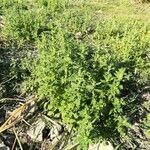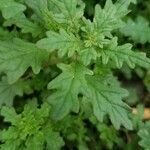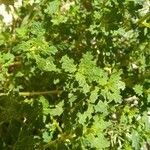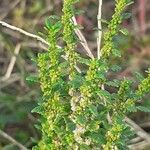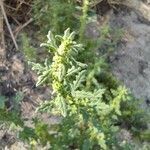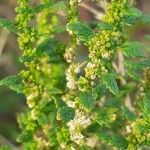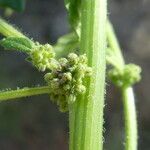Spreading annual or short-lived perennial, aromatic. Leaves sparsely pilosulose with simple and gland-tipped hairs, narrowly to broadly elliptic or ovate, obtuse, entire to sinuate or obtusely lobed; lamina 10–20 mm long; petiole slender, about ½ length of lamina. Flowers in compact axillary glomerules, subsessile or pedicellate, c. 0.5 mm high. Tepals 5, erect, united towards base, thin, sparsely pilosulose towards apex. Stamen 0 or 1. Fruiting perianth globular, c. 1 mm high, crustaceous, white; tepals erect, narrowly naviculiform. Pericarp transparent, adherent. Seed erect, lenticular, c. 0.5 mm long. Fruit dispersed with perianth.
Annual herb, up to 0.35 m high. Stems procumbent to suberect with branches up to 0.5 m long, main shoot up to 0.8 m high. Leaves with blade narrowly ovate to oblong, up to 14 x 6 mm, symmetrically sinuately dentate or lobed. Flowers: in axillary clusters; free part of perianth segments linear, rib-shaped, colour soon changing to yellowish white; Feb.-Jun.
Annual herb, 0.06-0.35 m high, with several stems arising from base, aromatic. Leaves elliptic to ovate, 10-20 mm long, obtusely lobed. Flowers in compound, axillary clusters, ovoid, 0.5 mm high. Flowering time July-Feb. Fruiting perianth usually crustaceous and white. Pericarp dull grey or translucent.
Prostrate to suberect herb with branches up to 500 mm long. Leaves narrowly ovate, up to 14 x 6 mm. Flowers in axillary clusters. Flowers green.
An annual herb. It grows 45 cm high. It can lie along the ground.
